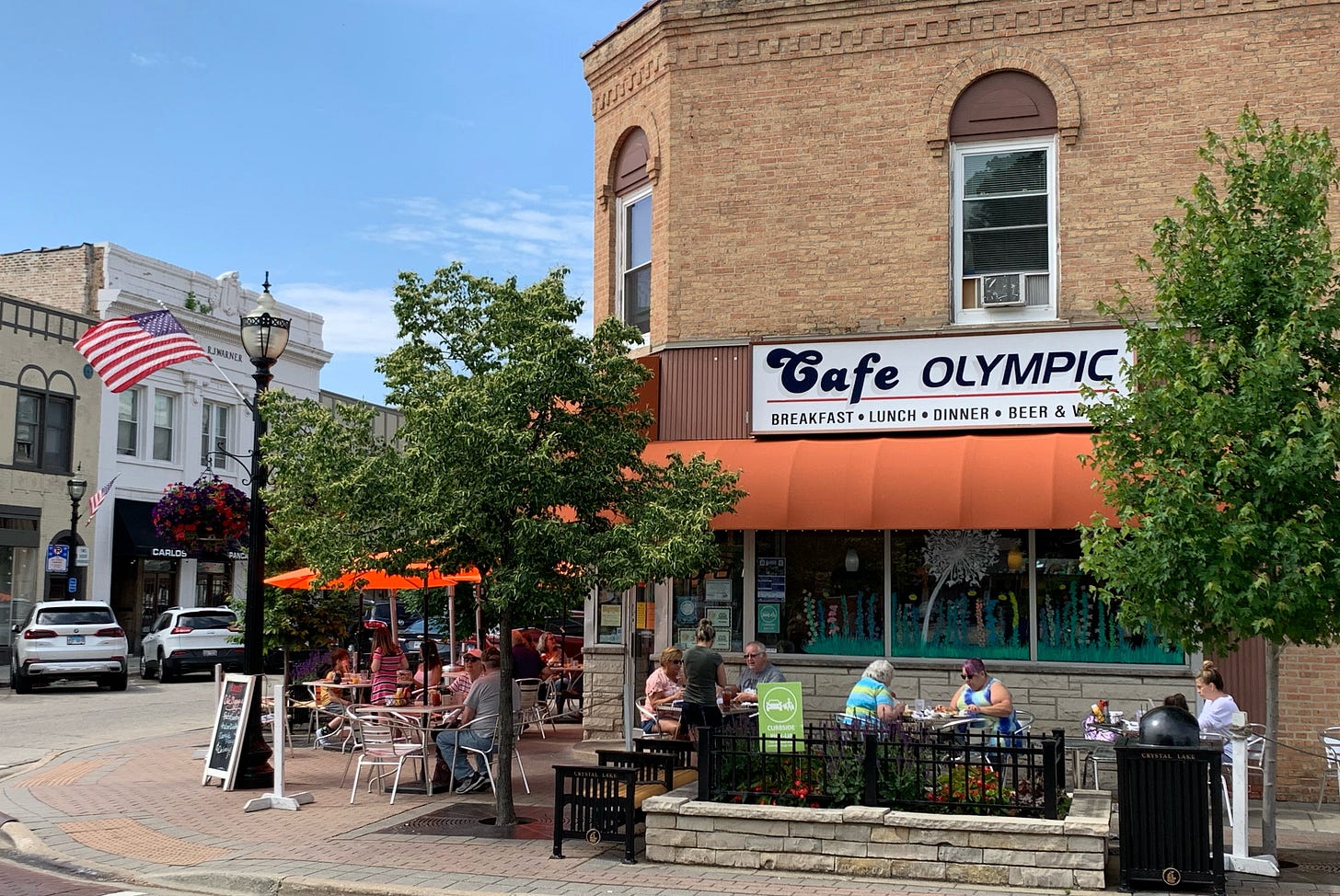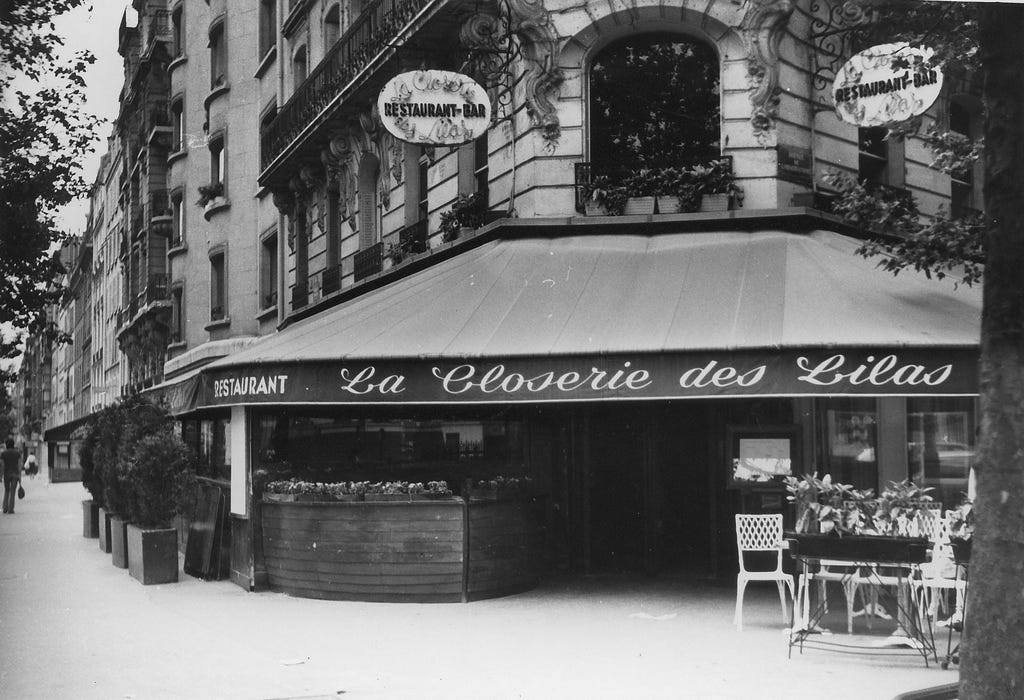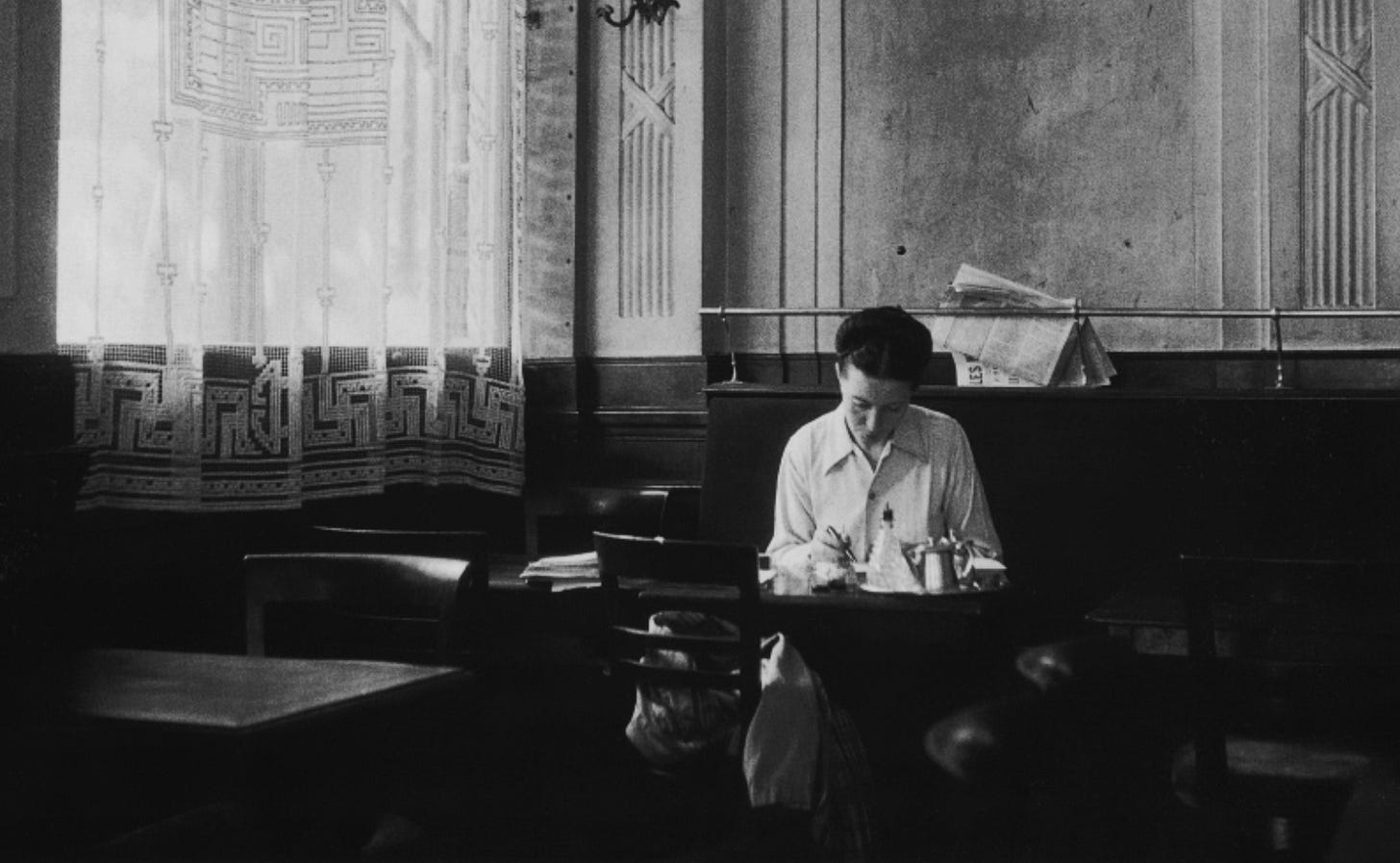Café
Cafés as intellectual and artistic hubs seem to be pretty much dead and gone, but there are other places for creators and thinkers to congregate and share their work — places like this.
Weekly Three
HEAR: A great track regardless of anything, “It Runs Through Me” by Tom Misch is my selection this week because it has some topic-related French café vibes ☕
READ: The Man Without Qualities is a notoriously long (and unfinished) novel by Austrian author Robert Musil. Sophie Atkinson, a writer who recently read the book, wrote a great essay about it with some interesting thoughts on embracing uncertainty.
VIEW: French artist Thomas Sauvin, based in Beijing, combs through a landfill to find film negatives, then develops them. The result? A beautiful mosaic of “ordinary Chinese life.”
No. 77: Café
Something awesome about the midwest?
(For those that don’t know, I recently moved from the SF bay area to Chicagoland).
I’ve recently discovered that my little town has not one, but two old-school cafés — and there may be more I’ve yet to find.
I’m not talking about Starbucks or IHOP or Black Bear Diner or similar chain restaurants.
I’m talking about what the IHOPs and Black Bear Diners and Dennys of the world try to neatly package and emulate: a true, relic-from-the-past, American café — the ones with long breakfast bars and spinny chairs; cozy booths and good coffee; regulars with newspapers in hand; one or two waitresses that have seemingly run the place since the beginning of time; breakfast plates that cost less than $5; pie; and plenty of retired old dudes who arrive at six and sip their mugs till nine.
One of them is called Andy’s. The other, in the heart of our “downtown,” is called Cafe Olympic.
But what is it about these cafés that feels so good?
Hard to pin down, but it has something to do with the genuine sense of welcome you experience when walking into one of these places. It’s like you’re being offered a space — the place where you sit — that’s forever your own, a gift from the owner to you. Seated, you’ve been assigned your role in the constantly unfolding drama of a morning at your hometown café. You can stay as long as you’d like, or come back as many times as you’d like, and no matter how much time has passed between the time you first stepped in the door or the last time you were there, the service, the vibes, and the neighborly love remains the same, like mom’s kitchen or a second home.
That’s rare, one of very few atmospheres I’ve found that comes close to the café experience I’ve daydreamed about since I first learned about the artist-crowded cafés of early 1900s Europe.
Um, did this guy just say he daydreams about cafés?
Yes, he did. Is that weird? Perhaps. But o well. Maybe you daydream about them, too, especially if you love reading, writing, and the arts and have realized that, in the past, cafés were more than just places for eating and drinking. They were intellectual hubs where artists gathered to chat, write, draw, share work, introduce each other, and on top of all these things, eat a good meal with a cup of cafecito or a strong drink.
Take Hemingway, for example, who spent much of his time in various cafés around Paris. He wrote the the whole of his Paris memoir, A Moveable Feast, at a café near his apartment in Montparnasse, La Closerie des Lilas — still open today — where he would arrive with a stack of notebooks, pencils, and a pencil sharpener, and spend the day writing and people-watching. It was there where he first read F. Scott Fitzgerald’s manuscript of The Great Gatsby, and, we can imagine, gave his cut-and-dry feedback. Other exciting, new thinkers of the day gathered at these cafés, too, people like Gertrude Stein, Simone de Beauvoir, Jean-Paul Sartre, and company. But of course, all was not academic and literary around the ashy tabletops: Hemingway and other members of the avant garde spent nights at cafés getting stupid drunk. So, they had that benefit, too.
One of my favorite writers, Elias Canetti, would also frequent cafés, his go-to’s being the establishments in and around Vienna. He would keep to himself with a glass of wine and his notebooks, working, meeting friends, and listening to the unique speech patterns of the people around him to inform his writing. In one of his memoirs, he remembers a scene from his childhood in which a café features prominently. Walking through Zurich with his mother, he spotted an egg-shaped head in the window of one of the popular cafés. It was Vladimir Lenin. Having been exiled from Russia, Lenin was writing, editing, and publishing his Marxist newspaper from a little roundtop by the window. What couldn’t you do in the cafés of the past?
Clearly these were the incubation chambers of up-and-coming artist and thinkers of the day, and to these cafés we owe our thanks for the heap of progressive ideas and beautiful epiphanies that were born within their lettered windows. But if these cafés supported this flowering of the arts, what the hell does this mean for us — our caféless bunch?
Yes, the little cafés in my town are awesome. They approach the essence of European cafés, but they are still far from what Hemingway and Canetti enjoyed 100 years ago. In Europe, even, the community creative vibe has apparently vacated the café and moved elsewhere. When I was a Paris a few years ago, I made it a point to visit one of the famous cafés I’d read about: Café de Flore, a favorite of Picasso. It was nice. My hot chocolate was good. But it had clearly been overrun by tourists and the wealthy Parisian elite. (My chocolat spécial flore, a.k.a. cup of hot chocolate with some coffee, was $12.) It was celebrated not for being an active artistic hub, but for having once been an active artistic hub.
This, for better or worse, is the state of cafés today. They are places to eat and/or to work or read in isolation. Very rarely are they places to spend all day and all night working, chatting, eating, socializing, drinking with all of your friends.
So what if you long, like me, to spend your time somewhere like these cafés of the past? The answer, you might be surprised to find, is to continue doing what you’re doing right now.
That is, using the internet in an intentional way by subscribing to the newsletters of the creators you enjoy, creating your own newsletter, starting conversation in the comments or via email after reading or seeing something interesting, sharing interesting ideas (articles/videos/books/art projects/links), promoting new artists.
It’s not as simple as saying, “The internet is our new turn-of-the-century Parisian café,” because, although the internet is the key to nearly infinite beauty, first you have to sift through a lot of worthless crap.
Rather, the turn-of-the-century Parisian cafés of our day — that is, spaces to have great conversations, share ideas, and enjoy artwork in a concentrated way, free from the boring, the unoriginal, or the just-plain-idiotic — are self-published newsletters like this one, blogs, and carefully curated websites. Here, there are no gatekeepers. Here, you are not reading something that’s been approved and revised by an editor. Here, and in other self-published spaces, you get the raw and unfiltered voice of the creator, as well as a space to respond with your raw and unfiltered voice.
And isn’t that really a lot like the cafés Hemingway and Canetti enjoyed?
I guess that’s part of the reason I’ve recently renamed this newsletter INTERNET DANCE CLUB — essentially, it’s the name of my café. Maybe the you’ll encounter an idea here that enhances your life, inspires you, and sparks conversation, just the same as if I was some guy sitting next to you in a Swiss coffee house, and we got to chatting, and we became lifelong friends and collaborators, and I share something with you, and you share something with me, and we are both better off because of it.
We could beat to death the question of whether the old school European café scene was better or worse than carrying out our discourse here, in substack newsletters. But why? This is what we’ve got.
So let’s make ourselves our own cups of coffee (or pour ourselves our own glass of beer), get comfortable, and enjoy the atmosphere. ♦
Mailbox
Have a question or response? Hit reply. Write-ups and questions from readers will be published here each week.






